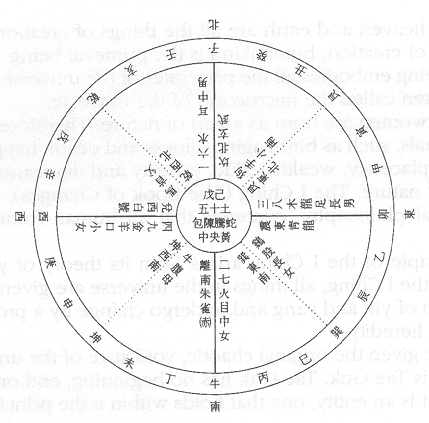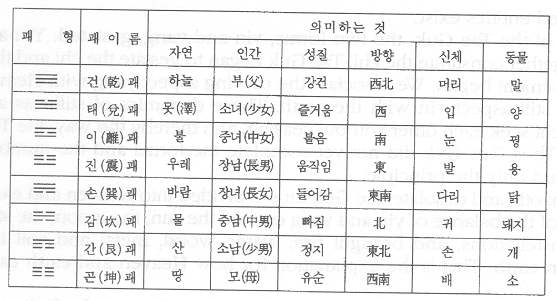
Who Is He?

By Sung Mo Koo
|
|
Who Is He? |
|
|
|
By Sung Mo Koo |
Chapter 1 - The Principle Of Constructing Secret Messages and How To Render Them In Plain Language
Secret messages, or prophecies, are literally messages that are sent in secret. To reveal the content of such a message, we have first to explore how it was hidden. A metaphor or syllogism is the main method to hide the meaning of a message, and there is a particular key to unlock Korean prophecies. That key is the principle of the I Ching.
The Kasachongron chapter of Kyuk-Am-Yu-Rok sets forth the system for deciphering the message according to the principles of the I Ching, such as the ten primal letters of Heaven, twelve basic letters of the earth, the numbers denoting change, the year, month, day and hour, and other more obtuse criteria. After deciphering the text, you have an unmistakable reconstitution of the original message. It is as precise as the splinters of a split bamboo that perfectly fit together.

(Chart 1: Directions)
In oriental philosophy, the universe has special, particular characteristics associated with the directions of east, west, south and north, and there are ten primal letters of Heaven and twelve basic letters of the earth. Please take a look at the following graph, which is an analysis of these characteristics.

(Chart 2: The ten primal letters of Heaven and 12 basic letters of the earth)
Heavenly Letters (Chinese Characters)
Earthly Letters (Chinese Characters)
Animals: Rat Ox Tiger Rabbit Dragon Snake Horse Sheep Monkey Chicken Dog Pig (Chinese Characters)
Between heaven and earth are all the things of creation, and among all the things of creation, humankind is the primeval being. Each individual human being embodies all the principles of the universe. Thus human beings are often called the microcosm of the universe.
Men and women are born as a part of nature. Therefore, the fortunes of all individuals, such as birth, aging, illness and death, happiness, anger, sadness, complacency, wealth, value, poverty and demeanor are dictated by the law of nature. The I Ching (The Book of Changes), the very center of oriental philosophy, contends that all human fortune is part of nature.
The Principle of the I Ching arises from its theory of yin and yang. According to the I Ching, all things in the universe are given existence by a combination of yin and yang and undergo change by a process that can be likened to heredity.
The name given the original chaotic, void state of the universe before the Big Bang is Tae Guk. Tae Guk has no beginning, end or boundary. It is round and it is an entity, one that holds within it the principle by which all created entities exist.
Out of the Tae Guk, the two forms, yin and yang, gestated. Yin and yang together constitute the chi. Tae Guk began to gestate the chi and thus self-movement began. We associate the moving aspect yang with Heaven and the still aspect yin with the earth. These dynamics of stillness and movement seek each other without ceasing, and thereby the Way, the Tao, begins. Thus, Tae Guk did not yet complete the forms and the numbers in it; it has only the principle.
A chaotic and desolate Tae Guk thus is divided into Heaven and earth. The act of the balance of yin and yang created the sun, the moon, the stars and constellations, and brought fire, water, wood, metal and soil into being on earth. This is the explanation for how Heaven and earth came to be.
Joo, Don-yi, in the Dynasty of Northern Song, first put forth the theory of the principle of yin and yang and later his disciples Jung, Ho and brother Jung, Yi completed it as the philosophical and moral foundation for Confucianism. Yin and yang further develop into four distinct forms of (big yang), (small yang), (big yin) and (small yin).
These four forms further divide into eight trigrams. The eight trigrams divide the characteristics of all things into eight categories of forms. These serve as the fundamental principles of change and development in the book of the I Ching. The eight trigrams are classified further into 64 trigrams to describe the characteristics of all created entities in even greater detail. Thus, even the changes in the path of human life, for better or worse, take place according to the law of nature.
This, in brief, is the principle of yin and yang, defining the basic principles underlying the construction and existence of all things in the universe, and corresponding on the human stage to man and woman.
Each existence in the universe is either yin or yang. This applies to all things that exist in the universe, including things both living and inorganic.
Refer to Chart 3 for the characteristics of the eight trigrams.
The I Ching denies that there is any reality that is fixed or stagnant. All things change and develop constantly. But in every change there is always a basic rule. Change does not take place outside of a principle. This premise is the great assertion of the I Ching and it is a great law. By combining the basic principles underlying change and additional directions, one can come to know the future.
Thus, we can understand the secret messages only with the aid of the principles espoused in the book of I Ching. These principles are for the most part presented in Graphs I through 3. These principles play the role of the key, so to speak, to unlock the secrets.

Chart 3
A locked door can be unlocked only if one uses the key by which it was locked. Similarly, to unlock a locked message one must utilize the principle by which the message was encoded. Without that principle, the message will remain elusive.
Now, what is the ultimate message toward which the Korean books of prophecy are pointing?
It is that in the last days of humankind, the eldest son of the Creator God will descend to the earth. He will teach and elevate all people on the earth to enable us to ascend to the level of heavenly men and women. He will bring God to us as humankind's actual true and direct parents themselves. This will create Heaven on earth. The message is also that the eldest son of God is the one who teaches and enlightens both spiritually and physically, alleviating human ignorance and thereby bestowing salvation. Thus he comes as the savior.
Book Six - Who Is He?
Sung Mo Koo
August 1998
Download entire page and pages related to it in ZIP format
Table of Contents
Information
Tparents Home